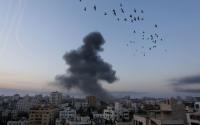26 November, 2003Baruch Kimmerling
Since 9/11, terror has become one of the most fashionable issues on both the American and the international agenda, and almost every publisher has rushed to publish a book written by one of the instantly created "experts on terrorism." These "merchants of fear," together with other interested political actors--such as the current leaders of the United States and Israel--thus unwittingly play directly into the hands of the terrorists, whose main objective is less to kill than to sow anxiety and panic. Ironically, from this perspective, Al Qaeda and the US Administration, as well as the Israeli right and Hamas, have a common aim: namely, to increase fear in order to recruit and manipulate their own people against their respective "other."
Historic though it was, 9/11 was neither the first attack against the World Trade Center--the symbol of American strength and values--nor against other grand American targets. During the past two decades, Middle Eastern terrorists have attacked US embassies, military ships and bases, and government personnel. In April 1983 a suicide bomber blew himself up in the US Embassy in Beirut, killing sixty-three people, including seventeen Americans. Six months later another suicide attack killed 241 American servicemen at Beirut International Airport. In 1993 a van exploded in the parking garage of the World Trade Center, killing six and highlighting it as a primary target of Islamist militants on American soil. In a coordinated attack in August 1998, suicide bombers attacked US embassies in Tanzania and Kenya, killing 224 people. Two years later the USS Cole was attacked in Yemen, taking the life of seventeen sailors.
This brief, partial count is presented just to suggest the profound changes that have occurred in postmodern warfare. Many of the world's most volatile conflicts, from Palestine and Afghanistan to Chechnya and Kashmir, pit powerful states against guerrilla or clandestine groups that, in the face of the adversary's overwhelming military superiority, have struck at civilian targets, turning their strategic weakness into a tactical advantage.
The states in question describe this violence as "terror," but the perpetrators and their constituents regard it as legitimate resistance to oppression. The current conflict in Iraq exemplifies this kind of "asymmetric" warfare. When Iraqi loyalist forces realized that they could not confront Anglo-American military might on the conventional battleground, they simply dissolved their army and handed the invaders an easy victory. Once the allied forces entered this trap, the Iraqis (joined, it appears, by foreign Arabs) began waging a highly efficient guerrilla war against them, and against anyone associated with the occupier, including the United Nations. Although they can't defeat the American military, with each attack they can whittle away at the American public's willingness to bear the costs of maintaining an increasingly unpopular occupation. Acutely sensitive to the threat, the American government has denounced these guerrillas as "terrorists."
Anyone who writes about terrorism is faced with the notorious problem of defining it. Even recently drafted international conventions, such as the Rome Statute, have avoided defining it while clearly stating that the intentional killing of civilians is a war crime under any circumstances, regardless of whether the act is carried out by a state or by other groups and even if those responsible regard the deaths as "collateral damage." But exactly who are civilians? This question is not as easy to answer as it seems. Consider, for instance, the case of Israel, a country that defines itself as a "nation in arms," in which civilians serve as soldiers, taking off their uniforms when danger has passed. The distinction between civilian and soldier is even murkier in the case of armed or unarmed settlers in the Israeli occupied territories, who are a clear extension of the Israeli military occupation. Arab defenders of suicide bombing, notably Sheikh Mohammed Hussein Fadlallah, an influential Shiite cleric in Lebanon, have argued that any Israeli is a legitimate target since all Israelis, men and women, serve in the military. As gruesome as this argument may be, it should hardly come as a surprise, since Israel itself fails to recognize such a distinction.
It is, of course, a commonplace that one person's terrorist is another person's freedom fighter. Joyce Davis, Barbara Victor and Jessica Stern are fully aware of this. Thus Stern defines terrorism broadly "as an act or threat of violence against noncombatants with the objective of exacting revenge, intimidating, or otherwise influencing an audience," a definition implicitly accepted by Davis and Victor. In fact, all three books lump together the use of violence by irregulars, guerrilla fighters and even "lone wolves" against military forces under the umbrella of "terrorism," failing to distinguish between legitimate acts of violent resistance, on the one hand, and war crimes, on the other. Nor do any of the books explore the issue of state terrorism, which often forms a bloody cycle with guerrilla terror. To their credit, however, all three authors seek to understand the motivations that lead people to commit acts of terror, without giving up their basic belief that no cause, no matter how just and noble, can justify the indiscriminate killing of innocent civilians. Their books differ widely in emphasis. Davis and Victor focus on political Islam and the Arab-Israeli conflict and their implications for US policy, while Stern examines terrorism in a wide range of contexts, from the Middle East and South Asia to the United States. But each book tries to answer a question raised by Davis, the deputy foreign editor at Knight Ridder: "What is it that would make a person crash a plane into a building, killing himself and everybody else? And what is it that would make a person strap explosives to his body and blow himself up?"






